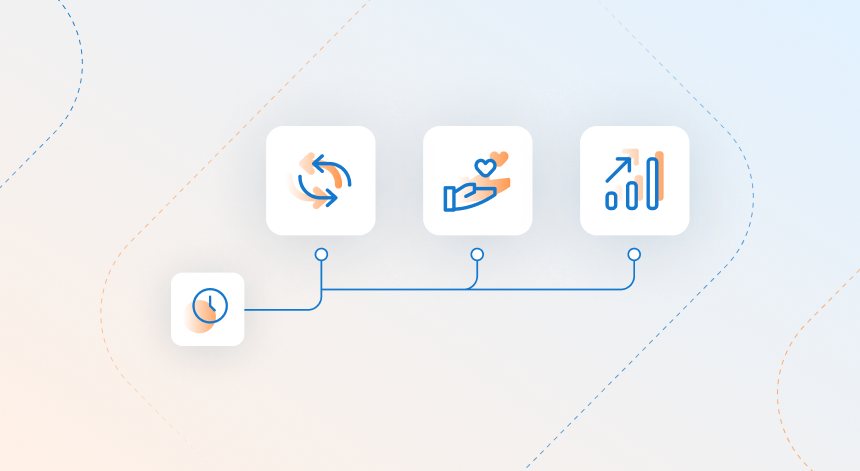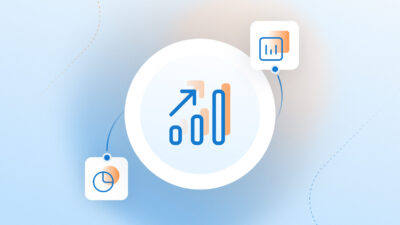Before you can convert free users into paying customers, you need to understand that most people don’t sign up for trials to check out your product. They sign up to see what kind of outcomes your product can produce for them.
It’s very rare for someone to look at your product and think, “Wow, look at that long list of features that FastSpring offers. I want to sign up and try that service!”
No, they’ll probably say something like, “Oh wow, they take on all the liability involved with collecting sales taxes and comply with every local jurisdiction around the world. I need something like that before we run into any penalties.”
If you want to convert trial users, you need to show them the value your product offers and how you’ll help them achieve a key outcome. Without that, most users won’t sign up for the paid version of your product, no matter how valuable or helpful you think it can be for them.
Luckily, you can take a lot of actions to influence that process and showcase your value. In this piece, I will walk you through a few strategies you can use to increase your free trial conversion rate.
What does “Free Trial Conversion Rate” mean?
Free trial conversion rate is the percentage of users that converted to a paid account from a trial period. Because the ultimate goal of using free trials for acquisition is to increase the number of paid users, your program’s success is based on looking at how often people upgrade from a free plan to a paid one.
In other words, your free trial conversion rate is an easy way to quickly measure how many users value your product enough to pay for it.
Why is it important to track your Free Trial Conversion Rate?
- It is a concrete way to optimize customer acquisition.
- It helps you find super customers and fine-tune your ideal customer profile.
- It provides insights into product functionality and onboarding.
Tracking your free trial conversion rate is important because it gives you a concrete way to optimize the way you acquire customers.
Most software companies rely heavily on free trials for customer acquisition. This is especially true for SaaS businesses, where it’s common for customers to either come in through or go through a free trial after an initial engagement method (think ads, news articles, or referrals).
And yet, many still treat free trial programs like the last step of the funnel. After the visitor “converts” from website visitor to trial user, they stop marketing or selling. But this is when you need to pay the closest attention to your prospects’ behavior. Look for inflection points where opportunities to drive additional value are naturally and easily presented, then nudge users to upgrade to a paid trial.
Tracking your free trial conversion rate can also tell you which audiences you should be focusing on. By segmenting your trial conversion data, you can determine which type of users convert to paid accounts at the highest rate and target them directly with your marketing campaigns.
Lastly, your trial conversion rate can also give you solid product and go-to-market insights. For example, if you’re getting tons of trial users, but only a small percentage of those trials are converting, there may be an issue with how your trial is set up or how your product delivers on its promise. You may be including too many features in the trial version. Or maybe the onboarding process is too complicated.
No matter the opportunity or issue, tracking your free trial conversion rate helps you understand if your strategy works for you (and your customers).
How To Calculate Your Free Trial Conversion Rate
To reiterate, the free trial conversion rate is the number of trial users converting to the paid account as a percentage of the total number of trial users during a given period. The point of conversion can happen anytime during or after the trial period has ended.
Free Trial Conversion Rate = (Free trials converted to paid users / All free trials) x 100
For example:
If you get 200 trial users within a specific time period, and 40 of those users convert to a paid account, your free trial conversion rate is 20%.
4 Reasons Why Free Trial Users Typically Churn
So why do some trial users convert while others churn? They cancel, deactivate, or never log in again. The most common reason is what I mentioned at the top of the article — your product didn’t meet the user’s expectations or drive the desired outcome.
Here are a few other reasons why trial users fail to convert. In the following sections, I will give you a few conversion benchmarks and tell you a few ways to solve these challenges.
- Not a good fit between what the user expects and what the product delivers. This often happens when your product serves multiple use cases or has too many features. If your marketing positions your product as a good fit for a specific use case, but the product doesn’t live up to the hype, you’re going to see it in your free trial conversion rate. This can play out in a few ways, like your product lacking proper features or uses incorrect terminology.
- The activation process solely focuses on conversion. Getting someone to sign up is great, but after that, you still need to get into the user’s workflow and make sure they’re building the sticky habits around using your product.
- Inefficient or broken onboarding experience. When this happens, users either don’t see your product’s actual value or understand it in theory but don’t think it’s right for their specific use case. If your product is difficult to use or navigate, your trial users may get frustrated and not take the time to fully explore what you have to offer.
- Pricing doesn’t match perceived value. This is an offshoot of the previous two, but this primarily happens because of a breakdown in value justification. If you nailed the previous two steps, you’re still having this problem, and it’s widespread), it may be worth conducting a pricing survey. There’s a science to SaaS pricing, and you should always be evaluating your pricing. But if this is not a widespread problem, you may be focusing on targeting people who are not likely to subscribe to your product in the long run.
What is a good free trial conversion rate?
Generally speaking, it’s hard to say what a “good” free trial conversion rate is because it depends on so many different factors. A B2B company offering a freemium product will have a very different conversion rate than a B2C company offering an opt-out free trial.
It’s also tricky to pin down benchmarks because there’s a huge gap between “good” conversion rates and the numbers that the best-in-class brands hit. Companies that are dominating their space can easily see free trial conversion rates hover over 25% — Slack converted 30% of their freemium users a few years ago. Some companies with an opt-out free trial may even be able to hit over 60%!
While those numbers do sound exciting, it’s worth noting that most companies may never surpass a 10% conversion rate on free trials. To understand why these conversion rates vary so widely, let’s talk about the different types of free trials.
Types of Free Trials
- Freemium. Freemium is a two-tiered acquisition model that splits users into either a free tier or a premium tier depending on whether they pay for an account. The free-tier users typically have perpetual access to a restricted version of a product. Companies that use this model generally are trying to drive rapid adoption or disrupt an incumbent, but you should know it’s easier said than done. It requires strategy and near-perfect execution.
- Opt-in Free Trial. Users can gain full access to the product or service for a limited time period without sharing any payment information upfront. Companies that use this model are typically trying to lower the barrier to entry by making it as easy as possible for prospects to start using the product. If you go this route, you should focus on getting users to the point where becoming a paying customer is the next logical step.
- Opt-out Free Trial. Users are required to share their payment information upfront in order to gain full access to the product or service during the trial period. This approach needs to be done with care as it can seem like you’re forcing the sale, especially if you’re offering a short trial period that doesn’t give prospects enough time to fully test out the product. Companies that execute this approach well see extremely high conversions; those who don’t often leave these customers with buyer’s remorse, leading to higher churn and negative reviews.
- Hybrid. A combination of the Freemium and opt-in/opt-out approach. Essentially, users are given full access to the product or service for a specified amount of time. At the end of the trial period, they are then given access to the Freemium version for as long as they want. But if they wish to access all the features and functionality again, they need to convert to a paid account. HubSpot and Adobe do this strategy particularly well. You can upgrade and get a taste of the premium experience, or you can downgrade and use the free version to your heart’s content. I’ve noticed that companies that use this approach typically have another way to make money off you (think data or advertising), or they have a lot to gain in terms of ROI if you sign up.
Conversion Benchmarks for Each Type of Free Trial
If we’re talking about what’s common, most people will tell you that the average free trial conversion rate typically sits around ~4%. Here are some average free trial conversion rates you can expect for different types of businesses, but note average does not mean guaranteed.
*Some of the numbers below were sourced from an article by Ada Chen Rekhi:
Freemium conversion rates are generally in the low single-digits, but as I said earlier, there are most definitely some outliers. Examples:
- Slack converted about 30% of freemium users in 2014
- After looking at companies like Zendesk, Evernote, GitHub, and SurveyMonkey, Insight Venture Partners says 1-10% is more common
- Dropbox converted about 4% of free users in 2012
- Evernote told FastCompany in 2010 they were converting about 6% of free users
- Lincoln Murphy from A16z says SaaS and B2B web apps usually convert at 3%
Opt-in free trial conversion rates vary from low single digits to upwards of 25% depending on the product category and target customer. Examples:
- Recapture.io touted a 25% conversion rate in 2016
- Customer.io’s conversion rate hovered between a 6-10%
- Totango’s study of ~100 SaaS companies found that 15% is pretty average for opt-in free trials
- GoToMeeting converted about 2-4% of free trials in 2011
- Salesforce, a name that is undoubtedly no stranger to anyone reading this, only converted about 3.75% of their free trials… note that this was back in 2006
Opt-out free trial conversion rates are significantly higher and range from 30–50%, mostly because payment information is collected up-front.
- 3 Minute Optimizer’s has a solid conversion rate between 30-40%
- Moz converted about 56% of free users in 2012
- Totango’s study of ~100 SaaS companies found that 50% is typical for well-executed opt-out free trial programs
- Callwave converted 40-50% of users in 2011
8 Strategies for Converting Free-trial Users into Paid Subscribers
Before we jump into the section you probably came here for, let me be very clear that none of the strategies below will fix your conversion problems overnight. Instead, these are tools that will help you reach your overall conversion goal—which should be to ensure that the product’s perceived value is always higher than the cost of the product and the friction the user experiences during the trial period.
With that said, let’s jump into our top strategies for increasing your free trial conversion rate:
1: Optimize your Trial User Journey for Conversions
As a marketer, I know that we’re constantly trying to use “best practices” or model what the “best-in-class” companies do. Still, sometimes you need to ask yourself whether or not the collection of best practices complement each other and create a seamless experience.
The best way to do that is to put yourself in the prospect’s shoes and go through the experience the way they do. Sure, I understand that you may want to pack that opt-in form with fields so you can improve the way you segment customers in your CRM system, but let me assure you that 40 fields are way too much. In fact, for most people, >3-4 fields is also too much.
Use this checklist to evaluate each step of your free trial signup process:
Before a free trial user signs up:
- Does each step have a consistent narrative from one to the other?
- Does each step in the process help the user accomplish a functional or emotional outcome they expected from the product?
- Are all the form-fields on your free trial signup page necessary?
- Does each step promise an improvement to the user’s status quo?
- Are objections, anxieties, or concerns addressed when they arise?
- Is the product’s language, messaging, and functionality consistent with the marketing?
- Are you establishing credibility with social proof, testimonials, and real-world outcomes?
- Did you remove all unnecessary points of friction and distraction from workflows?
After a free trial user signs up:
- Did the first run of the product lead to a specific, relevant, and meaningful quick win?
- Is the workflow for the first-run experience as streamlined as possible?
- Are you limiting the amount of time users spend waiting or in limbo?
- Are you using guided demos or product tours to help users get a quick win?
- Are you incentivizing or directing customers toward specific behaviors?
- Are you emailing customers to help them navigate the product or achieve an outcome?
I don’t recommend optimizing more than one of these at a time. If not, it will be difficult to know what change is actually influencing your conversion rate.
As a fun little experiment, you should try evaluating your favorite apps with this checklist. How do they measure up? Even the best companies will have at least a few things they can optimize at any one time.
2: Communicate Expectations Clearly Throughout the Trial Period
Most users want to know precisely what they’re getting into with free trials, and there are a few areas that you absolutely should cover when marketing your free trials. We’ll call those the basics. But if you really want to take your conversion rates to the next level, you’ll want to use some of the “advanced tactics” listed below.
Basics to communicate about a free trial
- Duration: how long does the trial last? This seems straightforward, but it can take on many forms. Are you using hours, days, weeks, or months? Does it start from the moment you sign up or the moment you log in? Being as clear as possible about this goes a long way.
- Features: what features are included with the free trial? This is especially important if you’re using the freemium model. Ideally, you’ll want to focus on the features or usage level needed, so users reach an AHA moment and want to convert into a premium account to use the tool more efficiently.
- Fees: how much does it cost if the user decides to sign up? Is it flat-rate, usage-based, tiered, or per-user pricing? Is there an activation or implementation fee associated with your product? Are users automatically billed or signed up for recurring payments? One of the biggest favors you can do to your customers AND yourself is to be extremely clear with what happens after the free period.
- Transition: At the end of the trial period, do customers lose access to the product if they don’t purchase the paid version? What if they want to save their progress or migrate their data? If you have a Freemium model, can trial users continue to access the product after the trial period? Does it change their experience at all?
- Cancellation: How do customers cancel their trial or paid version? Can they do it on their own, or do they need to contact customer success? If it’s an opt-out trial, do users have a grace period before they are charged for the full-service? As counterintuitive as it sounds, including cancellation information actually increases conversions.
Advanced communications that help increase conversions
- First impressions: You can set customers up for success with a good welcome email or onboarding email series. When done effectively, emails like this can be a powerful tool to keep users on track and turn them into long-term users. There are generally three elements you want to be sure you include in a welcome email. First, it should be personalized and timely. It should complement your in-app onboarding experience. And it should reiterate your app’s value.
- Automate prompts and alerts: Highlight important features with in-app prompts and notifications that you can preferably automate in advance. It may be hard to embrace automation for this critical moment, but automation tools can help with the tedious, difficult, or timely parts of the customer success workflow. But automation should never replace human interaction. Rather, it should make human interaction more targeted or thoughtful.
- Allow users to self-service: The goal of self-service resources is to answer potential questions proactively with a comprehensive product knowledge base users can access at their convenience. One of the most significant benefits of self-service onboarding is that it frees up your CS team’s bandwidth while allowing users to explore and learn about the features that matter to them. Most of all, it ensures you only trigger experiences to the right people, at the right time, which helps simplify your product during the trial period.
- Inspire users with examples: Sharing tips, templates, or inspiration from current users helps trial users onboard and understand the product quicker and more effectively. Brands that execute this well include MailChimp, Asana, and Airtable.
3: Make it Easy to Upgrade or Downgrade
Another way to get people to upgrade is to reduce friction anywhere that makes it harder for the user to move from a free account to a paid one.
Before I get into making it easy to upgrade, I need to emphasize that you should also make it easier to downgrade or cancel. The last thing you want is to be spending time and money on users that will never convert. I once worked at a job that had a marketing database with over 50,000 email subscribers, yet only about 10,000 of those emails were a good fit for our product. I’ll spare you the details, but let’s just say chasing those other 40,000 emails skewed our numbers and drained our budgets (over $100,000 USD on LinkedIn with no conversions).
Back to making it easy to upgrade. Try creating an account from scratch as though you’re a stranger, just to see what the process really looks like. Sometimes actions that seem easy on paper turn out to be logistical nightmares that take days, several email exchanges, and a few support tickets to complete.
Ask yourself:
- Do customers have to contact a sales representative or send an email to customer support in order to activate the account?
- Do they have to provide any personal info, like their name or email address, that they’ve already given and are now entering for the second, third, or fourth time?
- Do they have to fill out additional forms that take longer and require numbers that are not easy to calculate (revenue, transaction volume, blended rate for payment fees)?
4: Use Chatbots or Sales Tools to Proactively Handle Objections
Before most users switch to a paid version, they wonder about the few glaring questions that are holding them back. Questions like “will this end up being a time suck?”, “will I actually use this product long-term?”, “Is this a good fit for my team?” or “Will the cost justify the outcomes?”
No matter what the objection is, you must answer these, or they will surface later on (either with your sales team, customer success, or on a review board after they churned). Simply triggering an automatic message to visitors saying something like “have any questions about our pricing” when free trial users visit the pricing or upgrade page for longer than 30 seconds can help you increase your trial conversion rate.
5: Remind Users to Upgrade and Why Every Chance You Get
Many companies make the mistake of waiting until the end of the trial to get users to upgrade, but that’s often too late. Let’s say you have a 30-day trial period. Once the trial ends, you send them an email or in-app prompt that directs them to a paid subscription link. By the time they see the message and think about the offer, they may have gone a few days without the product. What if they realize they don’t miss it as much as you hoped? What if they forgot to log in and never used your software? Why would they start paying you after realizing they don’t need your product as badly as they thought?
Instead, find every excuse to remind these users that they are in a free trial period and that they have the option to upgrade to a paid account at any time.
A few ways to do this:
- In-app notifications that highlight everything they can do with a paid account
- Add call-to-actions in onboarding videos, support messages, and marketing emails
- Send periodic email notifications selling outcomes users might like
- Set up a notification system to alert users when the trial is about to expire
6: Use Checklists to Motivate Users to Stick Around
Checklists make your product more sticky, meaning they are more likely to keep using it for several reasons.
For one, the dilemma of sunk costs is activated. After a user completes a significant amount of progress and secures some quick wins, it’s less likely they’re going to opt-out of your product and do the same series of steps with a competitor. They want to keep that progress.
Using checklists also taps into a psychological effect called “endowed progress,” which basically means that the closer people think they are to completing something, the more likely they will see it through to completion. Humans love finishing what they’ve started, and there’s nothing wrong with tapping into that if you’re getting them closer to producing the outcomes that THEY want to for themselves.
After they complete a checklist, you can couple it with another strong psychological tactic: incentivizing users. MailChimp uses a virtual high-five when you send out a campaign. Asana has a unicorn that flashes across the screen when you complete a task. Why? Because they want you to experience a dopamine hit and make you feel like you’re doing something right.
This is a powerful way to help free trial users build long-term habits around your product.
7: Track Product Usage and Trigger Activity-Based Alerts
Once a user has signed up for a free trial, there’s no reason for an information blackout where you have no idea what stage the user is at in the process. If you don’t know where your user is in the process, having salespeople speak to them frequently is costly and potentially annoying.
If you have a free trial program and still suffer from the “black box” problem, it may be time to invest in a tool like Pendo, Mixpanel, or UserIQ to track your users, the actions they take and the features they use the most. (FastSpring uses Pendo).
These tools work well because they let you send emails based on activity triggers. Let’s say a user just signed up for a free account and click to create a product, but then they forget and exit the page. That user will receive an email from our email automation system and our customer success manager, along with a video and some self-service tutorials the user can follow to achieve the next step in the process.
Many trial programs ultimately fail because companies were not proactive in helping their customers advance through the trial phase. More often than not, the trial ends, and the user has never been activated. Using activity-based triggers can help you avoid this problem.
8: Personalize Communication for Every Stage of the Trial Period
When designing a communication plan to increase free trial conversions, you should consider creating a customized messaging plan for customers at every stage of the trial cycle. Here are some sample stages:
- website visitors who didn’t activate a trial
- customers currently in the trial period
- free trial users who didn’t purchase the paid version.
For example, let’s say you want to connect with free trial users who didn’t convert. You can use retargeting campaigns to nurture and support the customer during the trial period and encourage them to convert by:
- Reminding them when their free trial is going to end
- Offering them a limited-time discount for signing up
- Offering an extension to their trial period
How FastSpring Increases Free Trial Conversions
Whenever you sell software online, it’s always a good idea to have the right tools at your disposal. If you’re looking to increase your free trial conversion rate, FastSpring’s full-stack digital commerce solution can help you increase conversions by 30% or more.
But rather than talk a big game, we’d much rather show you how we can help you achieve your desired outcomes. Need to expand globally? We can help. Need to optimize conversions and increase your deal sizes? We can help. Need to manage churn and increase the number of users converting into long-term subscribers? We can help.
And if you don’t currently have a free trial program but think it might work for your software business, you should consider setting up a consultation with one of our commerce experts. This will save you countless hours and resources figuring out how to launch a world-class free trial or freemium model.
Here’s a peek at some of the quick wins you can get from our product:
- Set up installment plans or automatic renewals
- Showcase add-ons, upsells, and cross in a few clicks
- Accept payments in 20+ currencies and 23+ currencies
- Quickly create bundles, coupons, or discounts
- Enable usage-based billing or managed subscriptions
- Schedule and automate trial and billing reminders
- Support gifted subscriptions and limited sign-up periods
If you’re ready to convert more paid subscribers, schedule a demo today.









